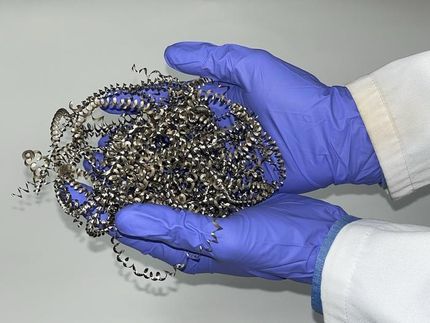On the Sunny Side: New photocatalyst for hydrogen generation works by irradiation with visible light
Making energy useable is a central problem of our civilization. Couldn't we simply imitate green plants and use photosynthesis to transform light into chemical energy? In principle, we could: hydrogen can be catalytically released from water to drive fuel cells that produce electricity. In theory, photocatalytic cells are easy to make. Simply put the catalyst in water, irradiate with sunlight, collect the hydrogen, and there you are. So what are we waiting for? It turns out not to be so simple after all.
"Everything depends on the catalyst," explains Akihiko Kudo of Tokyo University of Science. "To make the system commercially viable, the catalyst must use sunlight efficiently." In fact, there are a number of photocatalysts that split water upon irradiation with UV light; this leaves a large portion of the sunlight unused, however, because nearly all of these catalysts cannot make use of the visible portion of the spectrum. Kudo's team has now developed a new catalyst that works when irradiated with visible light.
Why is it so hard to develop the 'perfect' photocatalyst? This energy difference of the band gap in the light-sensitive semiconductor must correspond to the wavelength of the light in order for it to be absorbed effectively. Using the right combination of doped semiconductors, the scientists were able to put together a material with the right band gap. Their catalyst is a solid solution of zinc sulfide, copper indium sulfide, and silver indium sulfide (ZnS-CuInS2-AgInS2). When loaded with ruthenium metal, the result is a highly active photocatalyst with a significantly broader wavelength absorption.
The electrons and holes produced by the light must be taken up by the solution at the catalyst surface. The photocatalyst has to possess surface reaction sites on which the electrons and holes can take part in chemical reactions such as hydrogen production. This works when sulfides (S2-) and sulfites (SO3 2-) are present in the solution as sacrificial reagents, which irreversibly absorb the holes. The positively charged hydrogen atoms take up the electrons and form hydrogen gas.
"If this works in practice," says Kudo, "hydrogen could be obtained by using unwanted side-products from chemical factories and power plants: hydrogen sulfide and sulfur dioxide are sources of sulfides and sulfites."
Other news from the department science
Most read news
More news from our other portals
See the theme worlds for related content
Topic world Synthesis
Chemical synthesis is at the heart of modern chemistry and enables the targeted production of molecules with specific properties. By combining starting materials in defined reaction conditions, chemists can create a wide range of compounds, from simple molecules to complex active ingredients.

Topic world Synthesis
Chemical synthesis is at the heart of modern chemistry and enables the targeted production of molecules with specific properties. By combining starting materials in defined reaction conditions, chemists can create a wide range of compounds, from simple molecules to complex active ingredients.




























































